SALTWATER CHRONICLES FLY FISHING ADVENTURES IN SALTWATER (part 15)
| Sysadmin Note |
|---|
| Part 14 can be found here |
"Why bluegill? They are available to fisherman in nearly every state in the Union, their pugnacity is legendary, and their tenacious yanking, diving, twisting battles are unforgettable. They're fun, anywhere and just about any time."
Terry & Roxanne Wilson, Bluegill…. 1999
The saltwater fly fishing in Florida is so exciting and addicting that you sometimes forget that there other waters to fish and other species to catch besides the ones that live in the saltwater. In this column I will cover Peacock Bass, Bluegills and Redear Sunfish (Shellcrackers) and Black Crappie.
I will admit that I found the lure of the saltwater so great that I finally had to schedule freshwater fishing days or I fear that I would have had very little experience with warmwater fish in Florida. But I am glad that I started spending time chasing the fresh water species as they have afford me some excellent fishing, fond memories and many thrilling adventures on the water.
Now I will plunge into the subject at hand and begin with one of the most popular of the freshwater gamefish and that is the Bluegill.
Bluegill [Lepomis macrochirus] are also known as bream, brim, copperbelly, sunfish and many others they actually are cousins to the sunfish and they are among the native species of Florida. The bluegill occurs naturally in the United States east of the Rocky Mountains but have been transported across the country and around the world. They live in the shallow waters of lakes, ponds, and slow moving sections of rivers and streams and are school fish that gather in groups of 10 to 20 fish.
During the warm months of summer the bluegill will consume 35% of its own body weight on a weekly bases, they use a suction method when feeding so they approach their prey very closely. They are able to accomplish this as they have the ability to swim and change direction at high speeds. Bluegills are primarily daylight feeders as they feed by sight and have peak feeding periods occurring in the mornings and evenings.
Spawning occurs in the spring with water temperature of 67 to 80 degrees, in the North this mean May to June however in Florida the spawning period occurs from mid-February to April in a normal year. The Males will choose the spawning site and scoop out a depression in the bottom this normally occurs in shallow water around vegetation. Once the eggs laid the females are off to party central while the males defend the bedding area very aggressively and believe me they are aggressive.
Bluegills can live up to eleven years and during the first three years the growth rates are very rapid and then it begin to slow. The can tolerate a salinity of 1.8% and can also be found in the upper stretches of brackish water. Bluegills are found throughout Florida and they are one of the most fun fish that you can catch on a fly rod. Without a doubt the most popular fishing for Bluegills is during the spawning season however they can be caught throughout the year. Bluegills are also cousins of the Redbreast Sunfish Lepomis auritus and the Redear Sunfish Lepomis microlaphus which are also known as "Shellcrackers". The Shellcrackers can tolerate brackish water better than any of their cousin and are found throughout Florida and have a life span of six years. All have similar spawning times and habits and though the Shellcrackers have a decided liking for clams and other shellfish which have given them their nickname.
Another of the freshwater species that is found throughout Florida in the lakes and pond is the Black Crappie Pomoxis nigromaulatus has a lifespan of 15 years and the largest ever recorded was 19 inches in length and was just under six pounds. They are a schooling fish with the smaller fish feeding on all forms of aquatic life and the adults the actively seek minnows.
Here in Florida the spawning take place in March and April and the black crappie is a much sought after for the table.
The final species that we will discuss is the bright and colorful peacock bass [Cichla ocellaris] which is a non-native fish that was introduced by Florida Fish & Game in 1984 to control the growing population of spotted tilapia which is also non-native.
At first the peacock bass were only found in South Florida but now they are found in several area lakes and ponds in the state along with some of the freshwater canals. This introduction has created a much sought after gamefish due to its aggressive strike and hard fighting capabilities. The preliminary data shows that they live approximately six years and spawn from April through September and grow very quickly and will reach 12 to 14 inches within the first sixteen months and then will add about an inch per year, a seventeen inch peacock bass will weigh about three pounds, the largest Florida peacock bass reported was twelve pounds and twenty five inches in length. Peacock bass are very aggressive and will take both surface and subsurface imitation and they like shady areas.
There is a private lake on which my son owns a piece of property which has all of the freshwater speices including the peacock bass and the fishing for these various species is exciting, fun and the results are at time very tasty!
Normally I am using a four weight rod system during the time period of finding the bluegills on the spawning beds and during the rest of the time I am using a six weight rod system with floating lines, sink tips and type III full sinking fly lines.
Now I will share some of the patterns that I use on these species.
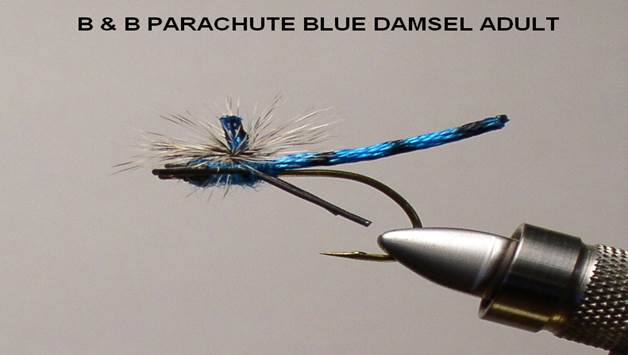
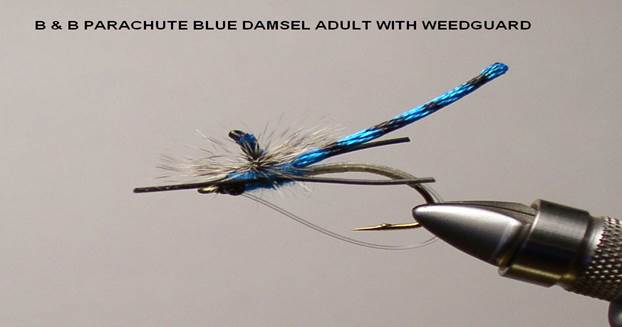
B&B PARACHUTE BLUE DAMSEL ADULT
- Hook: TIEMCO 8089 Sizes: 10 & 12
- Thread: Black 6/0 OR 8/0
- Weed Guard: (Optional) Apply 20 lb OR 25 lb Mason monofilament using 6/0 White Thread
- Body extension and wingpost: 2 mm blue nylon lace, banded with black marker. Both ends of the material need to be seared.
- Eyes: One pair of black mono
- Thorax: Dubbed, scintilla #85 Damsel blue
- Hackle: Grizzly dry fly hackle, tied parachute style
- Legs: Two black round rubber legs per side, tied Madam X style
NOTES: If you are using a weed guard, you will finish the weed guard before you wrap the parachute hackle. If no weed guard is being used, the parachute hackle is the last step in completing the imitation. This pattern may be constructed in several different color variations.
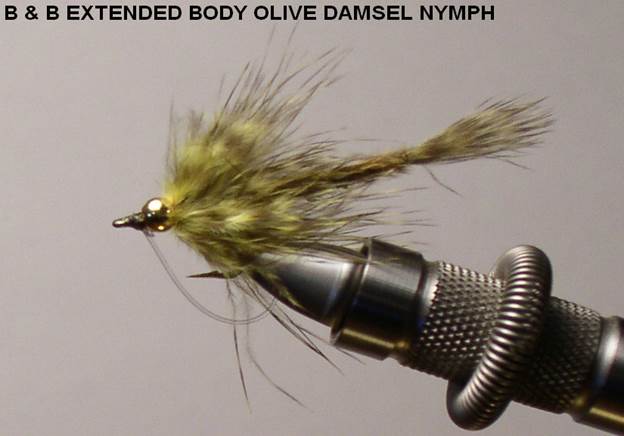
B&B EXTENDED BODY OLIVE DAMSEL NYMPH
- Hook: Tiemco 105 Sizes: 6-10
- Thread: Olive dun 8/0
- Weed guard: Two loos of 0x mono [optional]
- Bead: Metal, gold or copper as desired
- Body extension: The body extension is tied on a length of 0x tippet material strung between two vices.
- Tails: Yellow/olive grizzly marabou tips
- Body: Barred chartreuse marabou fibers, tied in by the tip and twisted with the thread and wrapped forward. Several bodies can be done at one time. After you finish spiraling the thread, touch it and the mono with a drop of super glue and begin your next body. They can then be cut apart and attached to the hook.
- Thorax and legs: Wrapped, two or three yellow/olive grizzly marabou feathers to the base of the bead
NOTES: This pattern is durable and has a great life-like swimming motion. It can be tied in many different color combinations to match the color of the naturals in your area.
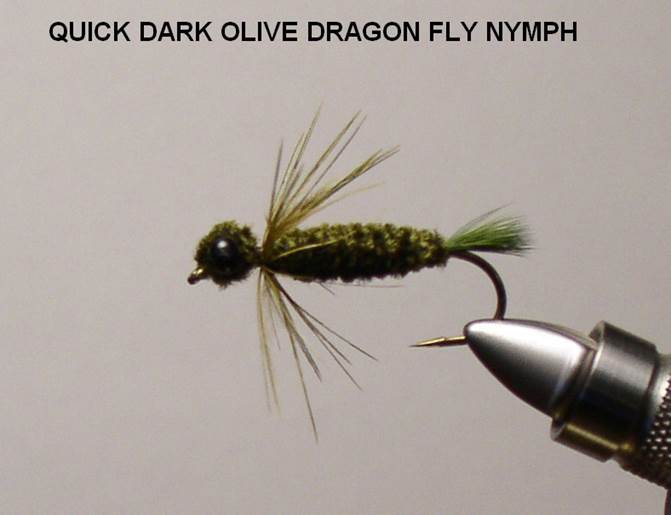
QUICK DARK OLIVE DRAGON FLY NYMPH
- Hook: Tiemco 5262, 5263 or 200R Sizes: 4 to 12
- Thread: Olive dun 6/0 or 8/0
- Tails: Dark Olive marabou tips tied short
- Body: Small dark olive chenille
- Eyes: One pair black mono
- Head: Small dark olive chenille
- Legs: Pheasant rump feather dyed yellow/olive
NOTES: Weighting the body should be done with lead fuse wire. I've found that brown, olive or black are the best colors.
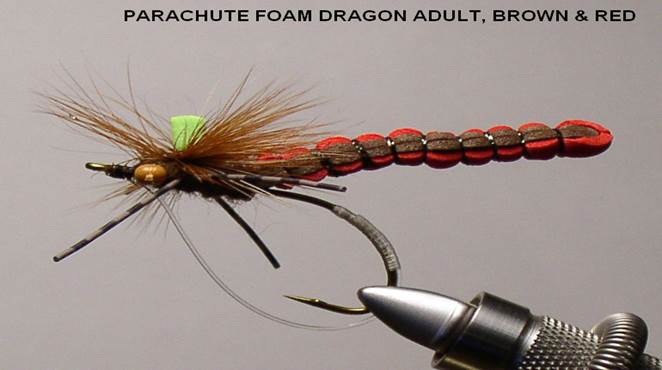
PARACHUTE FOAM DRAGON ADULT, BROWN & RED
- Hook: TMC 8089 Sizes: 2, 6, 10, 12
- Thread: Brown 6/0 or 8/0
- Body extension: The body extension is pre-tied on a long, thin doll needle, using dark fine ultra-thread. The body consists of two lengths of dry cell fly foam, a strip of brown with a thinner strip of red laid on top. This is folded over the needle. As soon as a base is secure tie in two strands of black Krystal flash. This will be twisted and wrapped through the body. The segmented body is made with the ultra-thread and the rib is spiraled through the body. Whip finish, glue and slide off the needle. Attach the body extension to the hook shank at the mid-point on the top of the hook shank. Attach the body with white 'A' thread, then switch back to brown 6/0
- Wingpost: 1/8 round bright foam post, yellow, orange or chartreuse as desired
- Eyes: One pair, brown mono
- Thorax: Dubbed, Scintilla #14 dark chocolate
- Hackle: One or two brown hackles, as desired, tied parachute style
- Legs: Two per side, tied X style, brown speckled rubber centipede legs
NOTE: If you desire a weed guard, use mono and white thread.
*More patterns next issue
| Sysadmin Note |
|---|
| Part 16 can be found here |
